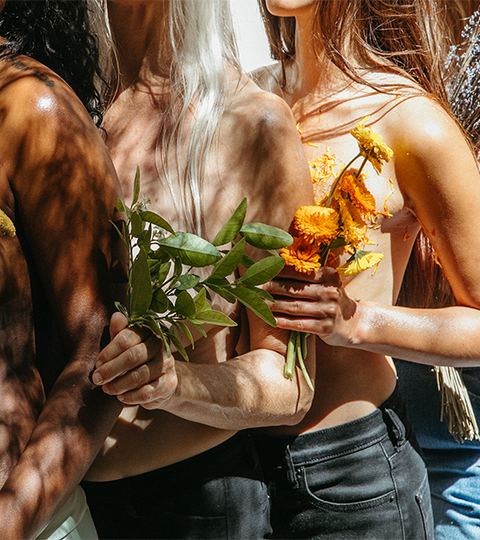Depending on who we are, where we live, and when we’re living, the word “intimacy” can evoke a whole constellation of images, concepts and aspirations. Are we talking about physical intimacy, e.g. sex? A true communion of kindred souls? Both?
It’s important to consider the possibilities and limitations of our ideas about interconnectedness, especially in times that are changing so fast. With our relationships often established and maintained primarily through technology, we’re both more connected and more isolated than ever before. Many of us feel dissatisfied, and it seems like a new vision is needed.
Sometimes it can feel like our ideas about intimacy are eternal and unchangeable, but the good news is that this couldn’t be further from the truth. Over time and geographical distance, people have had very different ideas about how intimacy is expressed, and the role it plays in our lives.
This is great news for those of us who feel stifled by society’s expectations of our relationships and the importance they have to us. Humans are malleable creatures, and by understanding the past, we’re that much closer to a fulfilling future – for all our essential intimate connections.

Sitting in a tree
Or very recently out of the trees, if you will. How did early humans experience sex and intimacy? We haven’t changed much physically in over 100,000 years – biological evolution happens on a long timeline, and if you saw a picture of an Ice Age Homo sapiens on Tinder, you probably wouldn’t bat an eye.
Although we can’t say for sure, the intimate relationships of early humans were likely much different from the nuclear-family cohabitation we think of as “normal” today. In order to survive, people had to live communally. Recent studies seem to show that not only were gender hierarchies more fluid, with people of all genders being considered relatively equal, relationships were as well – and polyamory appears to have been fairly common.
That fluidity even extended to inter-species relationships. Early homo sapiens existed alongside other hominids for thousands of years, and recent research shows that many of us have a hearty helping of Neanderthal DNA. It’s too bad we don’t have a record of what those relationships looked like – Neanderthals were human, though physically and socially quite distinct from their Cro-Magnon contemporaries. Our genes may tell a story of how intimacy can conquer even the most radical differences.

K-I-S-S-I-N-G
Kissing may seem completely natural to us and mandatory in relationships with lovers. Have we all been swapping spit forever? Not so – and to this day, there are many cultures that don’t kiss at all. For instance the Mehinaku of Brazil told one researcher, “Why would anyone want to share their dinner?”
Sharing dinner may actually be the origin of kissing. It’s controversial, but one school of thought holds that it began as an intimate activity not between romantic partners, but between parents and children – the act of “kiss-feeding”, or transferring chewed food from someone with teeth to someone without.
Regardless of its (possibly slightly icky) beginnings, kissing eventually caught on. The Kama Sutra, written in the 2nd century, has a whole chapter about it, and some believe that the Greeks learned about kissing when Alexander the Great invaded India in 326 BC. Curiously, kissing seemed to fall out of favor in Western cultures for around a thousand years after the fall of Rome, reemerging with the idea of courtly love at the end of the 11th century AD.
First comes love
For many centuries, romantic love was viewed with a great deal of skepticism in the West. Plato held that ideal love was non-sexual and non-romantic, reasoning that erotic attachment was inherently chaotic and vulgar. He thought that chaste love was more suited to access the wisdom of the Divine – hence the kind of affection that we call Platonic.
Even much later, stories like Romeo and Juliet served to illustrate the idea that romantic intimacy led to people doing stupid things, harming their families and their prospects. To put all this in historical context, the stability of social and family groups was much more important to society than anyone’s individual feelings, and people in love tend to not see much past themselves.
It wasn’t until a confluence of factors in the 19th century, including looming industrialization and the Enlightenment’s focus on individual freedom and happiness, that the joyous possibilities of romantic intimacy began to take hold as a primary value. For better or worse, some might say.
Then comes marriage
Intimacy between spouses hasn’t been a high priority for very long. For most of history and worldwide, marriage was a business arrangement and a way to manage resources, from the peasantry on up to kings and queens – and in many places, it still is.
The most common model for marriage is quite similar to traditions that originated as long ago and far away as ancient Mesopotamia, and included familiar concepts like dowry and divorce – but the one man, one woman, nuclear family rule is far from universal.
The Abrahamic religions’ model of polygyny, in which men were free to marry multiple wives, is well-known. But in rural Tibet some families still practice polyandry, a marriage structure in which one woman marries more than one man, and the Maasai people of Kenya and Tanzania practice both polygyny and polyandry.
In recent years, more people have come to realize that coupling up with one other person for life isn’t in their wheelhouse at all – and since most of us aren’t worried about keeping the sheep pastures in the family anymore, we’re free to express ourselves in nontraditional arrangements like polyamory and open relationships. No matter if it shocks the naysayers; human history and diversity demonstrate a wide range of possible blueprints for security and happiness.

It ain’t what you do, it’s the way that you do it
Over and over again, across the globe and throughout history, one message rings out clear and true: no matter how we express intimacy, sexual, Platonic and otherwise, it’s essential not only to our happiness as individuals but our survival as a species. No person is an island. We need to connect with one another to live fully.
No pressure, right? But if we examine the prescriptions we receive from the world around us, it becomes clear that none of it is mandatory. We can forge our own course, and in doing so deepen and revitalize our connections with other human beings – and the world as a whole.
There’s no right or wrong way to express interconnectedness, as long as it’s entirely consensual and undertaken with a generous and respectful spirit. So go forth, humans, and love as you will – and maybe one day the historians will write about new modes of intimacy in relationships, that will serve our bodies, hearts and minds better than ever before.
Want more? Sign up for our newsletter
By entering your email, you are agreeing to our terms and conditions and understand our privacy policy.




